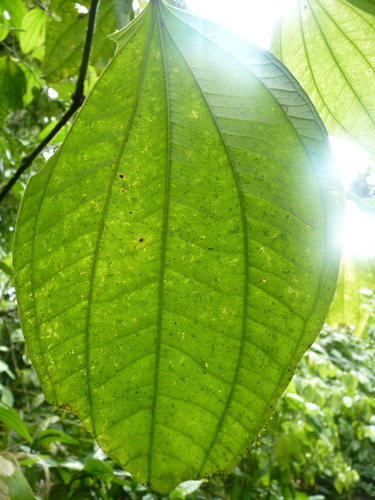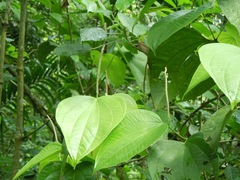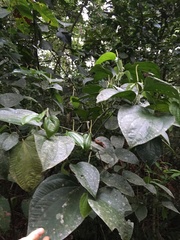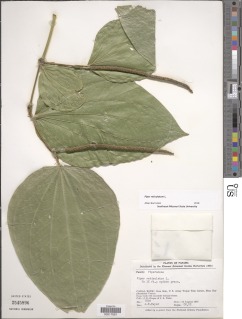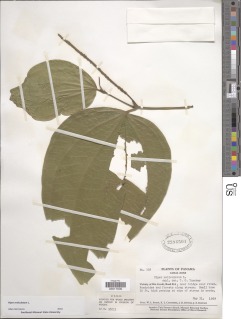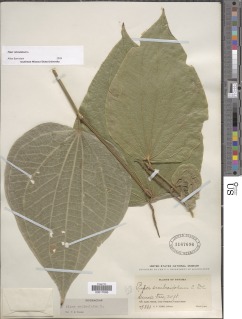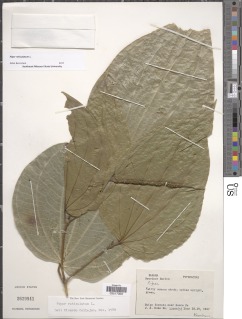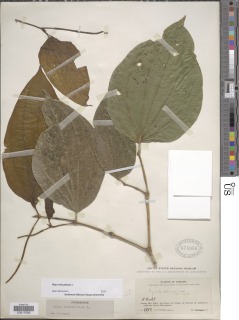

|
|
|
|
Family: Piperaceae
barrigon, more...canotillo, Hinojo
[Piper discophorum C. DC. ex T. Durand & Pittier] |
Description: A shrub or small tree, often with a leaning or forked stem. Where leaves emerge, the branches are conspicuously swollen. The leaves are large, thick, heart-shaped, with many veins arising from the base and radiating like a fan. Reproduction: Flowers and fruits both look like narrow stalks, about 1 cm in diameter and 20 or 30 cm long, curving upward from leaf bases. Can be seen any time of year. Distribution: Widespread in mature forest, secondary forest, and along forest edges, throughout the Canal area. Common in Gamboa and along most forest roads, at the forest edge, but never common inside the forest. Similar Species: The leaves are strange and very distinctive. Only other Piper species could possibly be confused. LK pipema Piper marginatum, LK2 which is also widespread along forest edges, has similar leaves, but they are thin and papery, unlike the thick, touch leaves of P. reticulatum. LK pipeca Piper schiedeanum also has thin and papery heart-shaped leaves, but is much less common. Descripción: Árbol o arbusto de 3 a 6 m de alto. Tronco en la mayoría de los casos múltiple y con raíces fúlcreas en la base. Ramitas terminales verdes, a veces con lenticelas blancas y nudos hinchados. Hojas simples y alternas, de 10-30 x 8-15 cm, ovadas, con ápice acuminado, bordes enteros y base redondeada o ligeramente cordada. Las hojas presentan de 5-6 nervaduras principales que recorren la lámina de la base al ápice. Pecíolo de 1-2.5 cm de largo y acanalado en la parte superior, con una estructura en forma de estípula corta y decidua. Flores blancas en espigas erectas. Frutos ovoides, de 0.1-0.2 cm de largo. Datos Ecológicos: La especie crece a bajas y medianas elevaciones, en bosques húmedos o muy húmedos. En Panamá se encuentra en las provincias de Bocas del Toro, Chiriquí, Coclé, Colón, Darién, Panamá y la comarca de Guna Yala. Crece en bosques secundarios y los márgenes de los senderos y los caminos. Florece y fructifica durante todo el año, principalmente de mayo a junio. Las flores son visitadas por abejas y otros insectos. Las semillas son dispersadas por animales que se alimentan de los frutos maduros. Especies Parecidas: A menudo se confunde con LK pipema Piper marginatum LK2 , pero en P. marginatum las hojas son aromáticas y tienen la base ampliamente cordada, además la inflorescencia es una espiga arqueada, lo cual no ocurre en P. reticulatum. Piper peltatum también tiene hojas parecidas, pero el pecíolo es peltado. Usos: Con las hojas se prepara un remedio para aliviar dolores de cabeza y de muelas. at anthesis, ca 2-2.5 mm wide, to 16 cm long in fruit and 4-6 mm thick; peduncles slender, l-2 cm long; bracts small, their stalk and margin bearded. Fruits obovoid, papillate, with a broad, smooth apical disk; styles 3 or 4, short and thick. Croat 14651. Occasional, in the forest. Flowering mostly from the middle of the dry season into the rainy season. The fruits develop throughout the rainy season, perhaps chiefly in the early rainy season, particularly in June and July. Because of its peltate venation it could be confused with P. marginatum, a species with smaller, thinner, more cordate leaves occurring in clearings and at the margins of the forest. The species is distinguished from all others on BCI by the prominent apical disk on its fruit. Standley listed this taxon as P. smilacifolium C. DC., which is not a valid name. Nicaragua to northern South America; West Indies; sea level to 700 m. In Panama, known from tropical moist forest in the Canal Zone, Bocas del Toro, Colón, Chiriqui, Panama, and Darien. See Fig. 190. |
|
|
|

